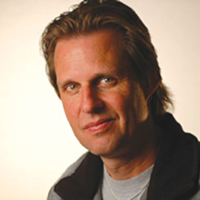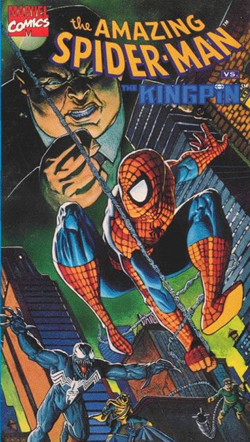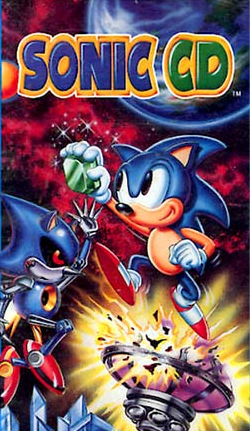Few artists are more closely tied to the Sega CD than Spencer Nilsen. As one of Sega’s in-house composers, he left his distinctive aural mark on such games as Batman Returns, Spider-Man vs. the Kingpin, and the king of them all – Sonic CD.  That last title caused some controversy upon its American release, thanks to the American arm of Sega deciding to change the soundtrack at the last minute. Nilsen was called in to score it, and the rest is history.
That last title caused some controversy upon its American release, thanks to the American arm of Sega deciding to change the soundtrack at the last minute. Nilsen was called in to score it, and the rest is history.
Sonic CD, however, is but a single title in a long list of works for games, television, movies, and the concert industry. Early in his career, Nilsen worked on productions for such artists as U2, Tom Petty, The Police, and The Who. he then moved on to scoring television shows and commercials, and eventually he found his way to Sega, where he served as head of the music department for several years. Nowadays, Nilsen is president and creative director of Ex’pression College For Digital Arts, an accredited college that prepares students for careers in entertainment production and technology.
Sega-16 was fortunate enough to chat with Mr. Nilsen about his time at Sega and his work on the Sega CD.
Sega-16: How did you come to be a part of the Sega Multimedia Studio?
Spencer Nilsen: I got a call out of the blue from SEGA asking if I had ever considered writing music for video or “computer” games. I answered with a question, “Do video games HAVE music?” I was familiar with arcade and crude Commodore 64 games, but had never even seen a console game machine. I was coming from records, concerts, TV, and film scoring and saw a tremendous opportunity to get in at the ground floor of an exciting and untamed new entertainment arena. There were amazingly creative, bright, articulate, well-educated people in the multimedia studio, who had the patience to teach me about games.
Sega-16: How complete was the audio set up at Sega compared to some other places you worked at? Did Sega give game audio its full attention in terms of equipment, or did you ever feel like you had to “make do” with what you had?
Spencer Nilsen: SEGA was just starting to realize the potential impact the right score and SFX could have on the game experience, especially as 16-bit, 44.1K stereo “Redbook” audio and better quality MIDI instruments became a reality. But essentially they had NOTHING, so for the first several months I worked on my own gear – in a cubicle no less – as we slowly acquired equipment and converted some crude space in a large broom closet (really!) into the original SEGA Studios. That was the first of four studios I put together for the company, the last being a 11,000 square-foot, two story complex in a historic building in the South of Market (SOMA) area of San Francisco. It was an awesome facility and we produced some exciting music there.
Sega-16: The music to Ecco the Dolphin is widely regarded as some of the best on the Sega CD, and many gamers love its atmosphere. How did you prepare to score a game that starred a dolphin? It definitely wasn’t your typical action game to score.
Spencer Nilsen: Yes, you’re absolutely right! Ed Annunziata, the mastermind behind the Ecco series, and a dear friend, came to me and said, “There is nothing human in this game – no people, weapons, cars, buildings… NOTHING! I don’t want the score to sound human either. How can we do the same with the music?” So I hired two synthesists/sound designers to help me create a large palette of completely original ocean-inspired “instruments” that i used to compose the tracks. The sounds they created were so inspiring and fun to write with! My good friend and colleague, David Young helped me tremendously, both technically and musically to bring the score to life. Our setup was massive with probably no fewer than about thirty synthesizers and keyboards (that’s my main instrument), along with amazing performances by a guitarist, percussionist, wind player, etc.
Sega-16: How did you come up with “Swing Time,” the theme for Spider-Man vs. the Kingpin for Sega CD? How did Eric Martin of Mr. Big get involved?
 Spencer Nilsen: Eric is a huge Spider-Man fan, from the comic books mostly. When he heard we were building a Spider-Man vs. Kingpin game for the Sega CD, he asked how he might get involved. So he and I got together and played around with some ideas based on a guitar riff he had in his head. He’s such a powerful, soulful singer that as soon as we started writing the lyrics, his voice and style started to guide us. When it came time to record the song, he was in the middle of recording a new album with Mr. Big. So i just grabbed a couple of ADAT digital recorders out of the studio at SEGA, ran over to Fantasy Studios in Berkeley where Mr. Big was set up, and had him track multiple passes of the lead and background vocals. Then I went back to my studio and edited together the final vocal tracks. We had an opportunity to perform “Swing Time” live a couple of times and had a blast! I saw Eric recently at a GRAMMYS event and we waxed nostalgic about that song.
Spencer Nilsen: Eric is a huge Spider-Man fan, from the comic books mostly. When he heard we were building a Spider-Man vs. Kingpin game for the Sega CD, he asked how he might get involved. So he and I got together and played around with some ideas based on a guitar riff he had in his head. He’s such a powerful, soulful singer that as soon as we started writing the lyrics, his voice and style started to guide us. When it came time to record the song, he was in the middle of recording a new album with Mr. Big. So i just grabbed a couple of ADAT digital recorders out of the studio at SEGA, ran over to Fantasy Studios in Berkeley where Mr. Big was set up, and had him track multiple passes of the lead and background vocals. Then I went back to my studio and edited together the final vocal tracks. We had an opportunity to perform “Swing Time” live a couple of times and had a blast! I saw Eric recently at a GRAMMYS event and we waxed nostalgic about that song.
Sega-16: Sega Visions magazine ran an interview with the some members of the Sega Multimedia Studio, such as Brian Coburn and David Javelosa, where David mentioned that you sat in on some of the early design meetings for Batman Returns on Sega CD. You obviously didn’t just remix the movie score, so what did you do to score the game in a way that was both original but faithful to the source material? That must have been a real challenge.
Spencer Nilsen: I was a big fan of Danny Elfman’s score for the original Batman movie, and that became my main inspiration, but I didn’t spend a lot of time listening to that score music because I really wanted what we did to be original. That’s why I chose to incorporate a lot of electric guitar. Greg Strong, an old friend and phenomenal musician, provided all the guitar work on the soundtrack. The way I like to work with Greg is to not give him a lot of time to “study” the pieces so that he doesn’t over think the parts. He is a tremendous improviser and I wanted that raw energy in the score. I also employed the talent and skills of drummer, Brad Kaiser, who provided live cymbal and hi-hat performances, but also programmed many of the drum parts for samplers and drum machines. I think together we created a compelling score, while keeping the overall sound and musical direction very original and unique to the game experience.
Sega-16: You’re listed as having done the animation score for Adventures of Batman & Robin for the Sega CD. That seems odd, considering that the game uses new animation from the makers of the actual television cartoon, why didn’t they just use music from the show?
Spencer Nilsen: I think it might have been a licensing issue, I’m not sure. I remember that project had to come together very quickly, like within a couple of weeks, and it was a ton of work locking the score-to-picture – not something you typically had to do, especially in those early days.
Sega-16: You undoubtedly know about the controversy the music for Sonic CD has spurred in many fans who really loved the original Japanese soundtrack. Why did Sega decide to rescore the game at the last minute?
Spencer Nilsen: Yes, I’ve heard many different opinions about which score is better, but I think it’s a ridiculous argument. They really represent two completely different musical philosophies and approaches. My impression was that the American marketers at Sega Of America wanted something a little more musically rich and complex, along with a theme song that they might get some mileage out of, while trying to promote the game. Adding the female vocalists (San Francisco jazz vocal trio Pastiche) to the project was an experiment that, by all indications, worked really well. In that game we are introduced to new characters, including Sonic’s female counterpart Amy Rose, or Princess Sally as she was known in the US version. I thought it would be a fun twist to have female voices supporting the gameplay as almost a subliminal hook.
I think the controversy surrounding the two versions of the game soundtrack were really blown out of proportion. Honestly, I’ve had hundreds of people tell me that they LOVE the score I wrote for that game, and I’m sure the Japanese version has tons of fans as well, so everybody wins in the end… as it should be! After all… IT’S ONLY A GAME!!
Sega-16: GameFan Magazine supposedly bashed the game upon its North American release, citing the soundtrack change as its primary reason. Did you ever think a simple change in music would spark such a reaction?
Spencer Nilsen: Again, I think critics were looking for reasons to bash the game, and so many critics are hardcore, loyal fans so their are not very objective. AND… they had all been playing the Japanese version for weeks or months before our version hit the streets, so it was like we replaced the music to Star Wars after the movie had been out for a while. From that perspective, I can’t blame them. But to be honest, the game critics were always very kind to me and my collaborators, so a little bad press ain’t the end of the world!
Sega-16: What was it like to work with Pastiche? We spoke to Sandy Cressman, and she had high praise for you.
Spencer Nilsen: The women in Pastiche, Sandy Cressman, Jenny Meltzer and Becky West, are phenomenal musicians and we had a blast creating the Sonic score. It was a lot of long days and nights in the studio, and because we had such a short turn-around on the project, we worked quickly and when we had something we liked, we recorded it instantly. My longtime collaborator, David Young, a fantastic musician, producer, and engineer in his own right, was so key to the success of that project, because he was able to help me write, arrange, and record on the fly, so that nothing got left behind. It’s easy to lose that important creative spark if you’re mired in technical challenges, and Dave is a very even-keeled professional, with a wicked sense of humor. When things would get too intense, Dave would crack us up with something completely obscure and hilarious. He is one of my favorite creative partners because he brings so much to the table – composing, playing, engineering, mixing – you name it and he does it well!
Sega-16: The opening and closing movies from Sonic CD, featuring “Sonic Boom,” were included in the museum in Sonic Jam for the Sega Saturn, and “Sonic Boom” was most recently revived as a remixed unlockable for Sonic in Super smash Bros. Brawl for the Wii. The song is widely regarded as the character’s theme song. Did you ever think it would come to be so much a part of him?
 Spencer Nilsen: No, to be honest I didn’t even know about these other uses of the song (I’m still waiting for my royalty check! LoL!) But all kidding aside, I’m thrilled and honored to be a part of such a strong legacy, and frankly, I don’t think I’d say that about some violent first-person shooter game, even if it sold a billion copies. Sonic has represented such a “positive” experience for millions of people all over the world, and we need so much more of that these days. As you know, I am the president and creative director of Ex’pression College for Digital Arts in Northern California, and MANY of the 1,100 students grew up playing games that I scored. As a matter of fact, there is one student who calls me “Mr. Hedgehog” because of that game. I’m so humbled when people tell me that the music I wrote impacted their lives in some small way. What more could a composer ask for?
Spencer Nilsen: No, to be honest I didn’t even know about these other uses of the song (I’m still waiting for my royalty check! LoL!) But all kidding aside, I’m thrilled and honored to be a part of such a strong legacy, and frankly, I don’t think I’d say that about some violent first-person shooter game, even if it sold a billion copies. Sonic has represented such a “positive” experience for millions of people all over the world, and we need so much more of that these days. As you know, I am the president and creative director of Ex’pression College for Digital Arts in Northern California, and MANY of the 1,100 students grew up playing games that I scored. As a matter of fact, there is one student who calls me “Mr. Hedgehog” because of that game. I’m so humbled when people tell me that the music I wrote impacted their lives in some small way. What more could a composer ask for?
Sega-16: Video games have lately been described as art by a lot of people, but this is usually in reference to the whole product, as opposed to specific parts on their own, such as graphics or music. Why hasn’t the musical aspect of the product been separated in regards to this issue? No one thinks less of movie soundtracks as compared to the rest of the music industry, so why do they do so with video games? For example, I can walk into any music store and go to the soundtrack sections, but most retailers don’t have one for video game music, which is on par in terms of quality and cost as soundtracks are. Why do you think this is so?
Spencer Nilsen: From what I gather, organizations such as G.A.N.G. (Game Audio Network Guild) are making a lot of headway toward the goal of having better representation among groups like NARAS (the folks who produce the GRAMMY Awards) and the Academy Awards organizers. People like Tommy Tallarico and Paul Lipson (the founder and the current president of GANG, respectively) are huge ambassadors for this effort, and through their diligence and hard work, they are starting to crack the code. While I was heading the music efforts for SEGA, we launched a game soundtrack label, Sega Music Group, which had the objective of releasing original soundtracks, and breaking new artists and bands through game soundtracks, similar to the way the movie soundtrack industry has evolved. Unfortunately, I think we were a little ahead of our time, and soon after we launched the label with partners at PolyGram (the largest record company on the planet at the time in the mid 1990s) SEGA imploded and our efforts were dashed. I’m optimistic that we will see many more game soundtracks hitting the market, and services like iTunes makes smaller venture less risky.
We have also started to see game composers cross over into film music, such as Michael Giacchino who scored Medal Of Honor before getting the nod on Ratatouille for PIXAR. This, of course, will help “legitimize” game music moving forward.
Our thanks to Mr. Nilsen for taking the time for this interview.

Pingback: Sonic the Hedgehog – Retrospettiva – Parte 3 - Urkin srl | Software house